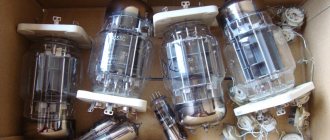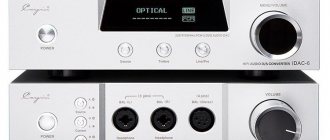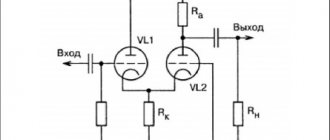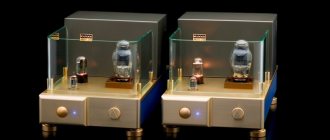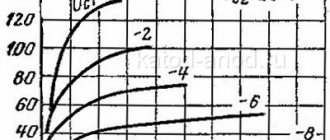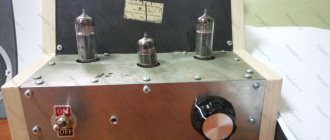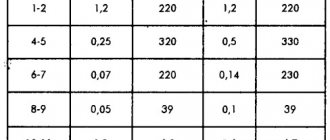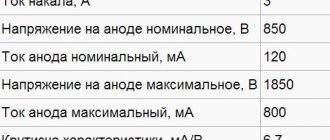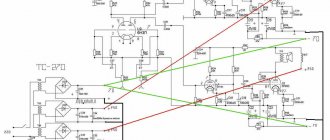DataSheet
| Lamp body 6ZH9P |
| |
Description
Pentodes with high slope characteristics for broadband amplification of high-frequency voltage in the input stages of radio-electronic devices. The design is in a glass shell, miniature. Weight 15 g. Basic parameters at Un = 6.3 V, Ua = 150 V, Uс2 = 150 V (for E180F Uс2 = 180 V), Uс1 = 0 V, Rк = 80 Ohm (for E180F Rк = 100 Ohm)
| Parameter | Conditions | 6ZH9P | 6ZH9P-E | E180F | Unit change |
| Analogue | — | E180F, 6688 | — | — | — |
| Filament current | — | 300±30 | 300+20-25 | 300 | mA |
| Anode current | — | 15±4 | 15±4 | 11.5 | mA |
| at the beginning of the characteristic at Uc1 = -8 V | ≤10 | ≤10 | — | µA | |
| Second grid current | — | ≤4.5 | 2.4+0.6-0.8 | 2.9 | mA |
| Reverse current of the first grid | at Uc1 = -2 V | ≤0.3 | ≤0.2 | 0.5 | µA |
| Leakage current between cathode and heater | — | ≤20 | ≤15 | — | µA |
| Slope characteristic | — | 17.5±3.5 | 17.5±3.5 | 15.9 | mA/V |
| Un = 5.7 V | ≥11 | ≥12 | — | ||
| Internal noise resistance | — | 150 | 100 | 90 | kOhm |
| Equivalent noise impedance | — | 0.35 | 0.35±0.25 | — | kOhm |
| Input impedance | at f = 60 MHz | 5 | 5 | — | kOhm |
| at f = 100 MHz | — | — | 2 | ||
| Vibration noise voltage | at Ra = 700 Ohm | ≤70 | ≤40 | — | mV |
| Interelectrode capacitances | entrance | 8.5±1 | 7.8±0.8 | 7.5+0.9-1.1 | pF |
| day off | 3±0.5 | 2.7±0.8 | 3.5±1 | ||
| checkpoint | ≤0.03 | 0.02-0.03 | 0.03 | ||
| cathode heater | ≤7 | 4.5-6.5 | — | ||
| Running time | — | ≥2000 | ≥5000 | 10000 | h |
| Criteria for evaluation | |||||
| Reverse current of the first grid | — | ≤1.5 | ≤2 | ≤1 | µA |
| Slope characteristic | — | ≥11 | ≥11 | ≥11 | mA/V |
| Changing the slope of the characteristic | — | ≤±25 | ≤15 | — | % |
Operating limits
| Parameter | Conditions | 6ZH9P | 6ZH9P-E | E180F | Unit change |
| Filament voltage | — | 5.7-7 | 6-6.6 | 6-6.6 | IN |
| Anode voltage | — | 250 | 160 | 210 | IN |
| with the lamp locked | 285 | 285 | — | ||
| when turned on | — | — | 400 | ||
| Second grid voltage | — | 160 | 150 | 175 | IN |
| with the lamp locked | 285 | 200 | — | ||
| when turned on | — | — | 400 | ||
| Negative voltage of the first grid | — | 100 | 100 | 100 | IN |
| Voltage between cathode and heater | at positive heater potential | 100 | 100 | 60 | IN |
| at negative heater potential | 150 | 100 | 60 | ||
| Cathode current | — | 35 | 22 | 25 | mA |
| Power dissipated by the anode | — | 3 | 3 | 3 | W |
| Power dissipated by the second grid | — | 0.75 | 0.45 | 0.9 | |
| Resistance in the first grid circuit | — | 1 | 0.5 | 0.5 | MOhm |
| Lamp bottle temperature | — | 130 | 130 | 155 | °C |
| Resistance to external influences | |||||
| Acceleration | with vibration with a frequency of 5-600 Hz | 6 | 6 | — | g |
| with multiple impacts | 75 | 150 | — | ||
| with single strikes | — | 500 | — | ||
| permanent | — | 100 | — | ||
| Ambient operating temperature range | — | -60…+150 | -60…+100 | — | °C |
For a description of all parameters, see the letter designations of the radio tube parameters.
Anode characteristics
Anode-grid characteristics
If you find an error, please select a piece of text and press Ctrl+Enter.
Radio lamp 6ZH9P
Radio lamp 6ZH9P A directory of the content of precious metals in radio components based on reference data from various organizations involved in the processing of scrap radio components, device passports, forms and other open sources. It is worth noting that the actual content may differ by 20-30% downwards.
Radio tubes can contain gold, silver, platinum and PGMs (Platinum group metals, Platinum group, Platinum metals, Platinoids, PGE)
Content
Content of precious metals in the radio tube: 6Zh9P
Gold: 0.0001193 Silver: 0 Platinum: 0 MPG: 0 According to data: from the Roscosmos list
An electron tube or radio tube is an electric vacuum device (more precisely, a vacuum electronic device) that works by controlling the intensity of the flow of electrons moving in a vacuum or rarefied gas between the electrodes.
Main types of electronic vacuum tubes:
Diodes (easily made for high voltages, see kenotron) Triodes Tetrodes Pentodes and Beam tetrodes Beam pentodes (as a variation of this type) Hexodes Heptodes (pentagrids, five-grid) Octodes Nonodes Combination lamps (actually include 2 or more lamps in one cylinder) Discharge lamps
Designation system for lamps produced in the USSR
The first part of the marking is a number indicating the rounded value of the filament voltage (for receiving and amplifier lamps): 06 - 625 mV 1 - 800 mV, 1 V, 1.2 V, 1.4 V, 1.5 V 2 - 2 V, 2.2 V, 2.4 V 3 — 3.15 V 4 — 4 V, 4.2 V, 4.4 V 5 — 5 V 6 — 6 V, 6.3 V 7 — 7 V 9 — 9 V 10 — 10 V 12 — 12 V, 12.6 V 13 — 13 V 17 — 17 V 18 — 18 V 20 — 20 V 25 — 25.2 V 30 — 30 V
Generator tubes, barretters and zener diodes have a letter index indicating the type of lamp: GI - Pulse generator tube GM - Modulating tube GMI - Pulse modulation tube G - Generator tube (for older lamps) GK - Generator HF lamp (for frequencies up to 30 MHz ) GU - (For example, GU-50 Generator VHF lamp (for frequencies up to 300 MHz) GS - Generator microwave lamp (for frequencies above 300 MHz) GP - Regulating lamp GPI - Regulating pulse lamp SG - Gas-filled voltage stabilizer (zener diode) ST - Gas-filled current stabilizer (baretter)
The second part of the marking is a letter (or two letters) of the Russian alphabet, indicating the type of electrode system of the lamp (for receiving and amplifier lamps): A - Frequency-conversion lamps (hexode, heptode) B - Diode-pentode, double diode-pentode (combined lamp) C — Lamp with secondary emission G — Diode-triode, double diode-triode, triple diode-triode (combined lamp) D — Single diode (except for rectifier kenotron) E — Electron-light indicator G — High-frequency pentode with a short characteristic I — Triode- heptode or triode-hexode (combined lamp) K - High-frequency pentode with an extended characteristic ("varimu") L - Beam lamp (except for the beam tetrode) M - Double pentode (only one lamp of this type was produced - 12M1M) N - Double triode P - Output pentode or beam tetrode P - Double tetrode, double beam tetrode or double pentode C - Triode T - Thyratron with a cold cathode (only one thyratron was produced with the designation adopted for receiving and amplifying tubes - 1T1A) F - Triode-pentode (combined tube ), exception - pentode of the old production 6F6S X - Double diode (except for kenotrons) C - Rectifier diode (kenotron) of any type E - Tetrode SR - Double pentode-triode
For cathode ray devices: LI - Transmitting tube LC - Kinescope with electromagnetic beam deflection LM - Oscillographic tube with electromagnetic beam deflection LN - Storage tube LNS - Character-printing storage tube LO - Oscilloscope tube or kinescope with electrostatic beam deflection LP - Cathode-ray switch LS - Character-printing tube LF - Functional tube
The third part of the marking. For generator and receiving-amplifier tubes, picture tubes and oscilloscope tubes there is a number indicating the development number. For zener diodes and barretters it is the same as the 4th element for receiving and amplifying tubes.
The fourth part of the marking. It is absent for zener diodes and barretters. For picture tubes and oscilloscope tubes, it can indicate the type of phosphor used for the screen. For receiving and amplifying lamps - a letter indicating the design of the lamp: A - Subminiature glass cylinder with a diameter of 5-8 mm with flexible wire leads B - Subminiature glass cylinder with a diameter of 8-10.2 mm with flexible wire leads D - Miniature glass cylinder with a diameter of more than 10.2 mm with flexible wire leads D - Ceramic cylinder with disk leads ("beacon" lamps) F - Acorn-type lamp - a miniature glass cylinder with rigid radial leads. K - Ceramic cylinder with pin leads. L - Lamp with an octal base equipped with a lock, which prevents the lamp from falling out of the panel when shaking (“octal”). The cylinder is glass, covered on the outside with an aluminum casing. M - Small-sized glass cylinder with an octal base of reduced height (“malgab”). The letter is retained only for some lamps of older releases (2K2M, 2Zh2M, 2P9M, 30Ts1M, etc.). N - Nuvistor (miniature lamp in a metal-ceramic cylinder). P - Miniature (“finger”) lamp — a glass cylinder with a diameter of up to 22 mm with seven (“heptal”) or nine (“noval”) rigid leads soldered directly into the bottom. C - Large glass cylinder with a diameter of more than 22.5 mm or a metal-ceramic cylinder, including one with an octal base. P - Subminiature glass cylinder with a diameter of less than 5 mm with flexible wire leads. The only lamp produced in this design was 1Zh25R) No letter - Metal (usually steel) cylinder with an octal base
For generator lamps - a letter indicating the type of cooling: A - Forced liquid, water or air-water B - Forced air K - Contact P - Evaporative No letter - Natural air
The fifth part of the marking characterizes the special properties of the lamps. Optional, always placed with a hyphen, applicable only to receiving and amplifying lamps. B - Lamp of increased mechanical strength and reliability E - Lamp of increased durability (5000 hours or more) D - Lamp of particularly high durability (10,000 hours or more) I - Lamp designed to operate in pulsed mode K - Lamp of increased mechanical strength and reliability with increased vibration resistance P - Lamp of increased mechanical strength and reliability, with increased radiation resistance (better than B; however, to replace a group B lamp, both P and B must be present in the designation)
Share link:
Liked this:
Like
Similar
TUBE AMPLIFIER FOR HEADPHONES
But my baby lamp has been working properly for a year now. Assembled and tested specifically for fans (amateurs, and not only) of the 6ZH1P pentode, why is this so - it’s simple, this lamp is so not in short supply that, having climbed the bottom of the barrel, I scraped together two dozen. In a triode connection, 6ZH1P is equivalent to a 6S1P triode.
Here are the parameters I got for a single-ended cascade. 6Zh1P measurements in a test triode connection:
- Ua=85V Ua=126V
- Uk=2V Uk=2.2V
- U=250V U=250V
- Ra=47kOhm Ra=12kOhm
- Rk=620 Ohm Rk=220 Ohm
- Ck=150mF Ck=150mF
- Uin=~1V Uin=~1V
- Uout=27V Uout=23V
- KHI=0.7-1% KHI=0.25-0.4%
- Frequency response 5 Hz-200 kHz at level -3 dB
For experiments, use any low-power pentode, for example, 6ZH1P (the letter Zh in the lamp marking means a pentode with a shortened lower bend of the anode-grid characteristic) from finger lamps. The circuit is a simple single-stage low-frequency amplifier. Use a rectifier to power the amplifier. Check the installation with the circuit diagram, turn on the power and apply a low-frequency signal from an MP3 player, from a computer output or from a DVD player to the amplifier input. The lamp will amplify the signal, and the headphones will convert it into sound vibrations.
Resistor R2 in the cathode circuit is an automatic bias resistor. The voltage created across it is supplied to the control grid through resistor R1. Capacitor C3 closes the alternating current component of the shielding grid circuit to the cathode. Without it, during operation of the lamp, the voltage on the shielding grid will pulsate with the frequency of the amplified signal and parasitic feedback will arise between the anode and the control grid.
The capacitance of this capacitor must be such that it does not provide significant resistance to vibrations of low frequencies of the amplified signal. In a tube headphone amplifier, this requirement is met by capacitors with a capacity of at least 0.05 µF.
In the diagram of one of the possible options for a low-power amplifier for low-impedance headphones (4-16 Ohms), we use small output transformers of the TVZ1-9 type. Here the output stage is shown in the pentode connection of the lamp. For stereo you will need two similar channels.
And here is the actual ULF circuit that was used for my device. Just don’t forget, we turn on the lamps with triodes. The ULF itself is drawn only for one channel, the second is the same.
By the way, the 6zh1p lamp (analogous to EF95) also allows a reduced supply voltage. See the diagram below for options for ultra-low-voltage tube headphone amplifiers.
In terms of the case and design - what will you get? In the photographs you can see the metal case from the power supply of the antenna amplifier of the Senao phone. In general, I am extremely pleased with the sound of the resulting tube headphone amplifier!
In terms of power, believe me, it’s enough, the output amplitude jumps to 1.5 volts, with an impedance of 32 ohms.
But don't forget! The beauty of this amplifier directly depends on what you are going to listen to. Chinese bananas for $5 would be out of place here. In general, the device is made according to all HI-END rules and, despite the minimal costs, is not particularly inferior to brands. Photo by: -igRoman-
Tube Amplifier Forum
- POCKET TUBE AMPLIFIER WITH BATTERY
- LOW VOLTAGE TUBE UNCH
- POWERFUL TUBE UNCH FOR HEADPHONES
- TUBE ULF FOR 6P14P AND 6N2P



